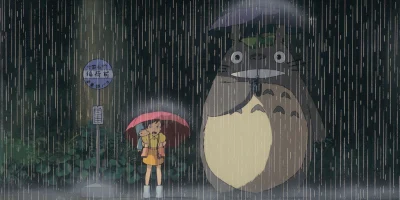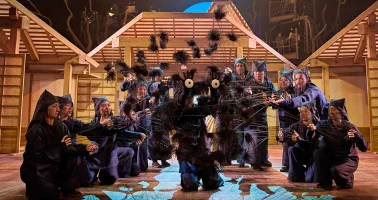
'My Neighbour Totoro' review – this Studio Ghibli adaptation is theatre at its most magical
Read our review of My Neighbour Totoro in London, Tom Morton-Smith's new stage adaptation of the Studio Ghibli film originally created by Hayao Miyazaki.
The best entrance you’ll see in a theatre this year belongs to the title character in this feverishly anticipated stage version of Studio Ghibli’s 1988 anime film. Behind the curtains, a giant silhouette gradually appears, and when those curtains swing open, we finally see him: a huge shaggy mass, so enormous, so peculiar and so utterly beguiling that the audience breaks into rapturous applause. It’s the moment that we know, behind doubt, that the RSC has got this exactly right: My Neighbour Totoro is going to be a massive hit.
In fact, the production was a record-breaker before it even opened. It’s the fastest-selling ticket in Barbican history – beating the previous holder, Benedict Cumberbatch’s Hamlet. The Japanese Studio Ghibli has a passionate international following thanks to work like the Oscar-winning Spirited Away, Howl’s Moving Castle and My Neighbour Totoro. But could the studio’s very specific aesthetic and tone really be translated to the stage?
Absolutely. Tom Morton-Smith’s adaptation strikes a perfect balance of honouring Hayao Miyazaki’s creation and seeking a new theatrical language, brilliantly realised in Phelim McDermott’s exquisite production. The 1950s-set story is a fairly simple one: 10-year-old Satsuki and four-year-old Mei move with their father from Tokyo to the countryside, so they can be nearer to their hospitalised mother, who has tuberculosis. There they encounter the extraordinary spirits of the forest, like Totoro. That leaves plenty of room for flights of imagination, and for beautiful detail in the world-building and relationships.
Most effectively, the production keeps us in that child’s-eye view. McDermott plays cleverly with scale: the goat is larger than usual, because it’s being viewed by an alarmed – and petite – Mei. We only hear snippets of adult conversations, particularly about the mother’s health crisis. But we’re fully immersed in that childlike awe at each discovery: the city girls’ pleasure at collecting acorns, watching tomatoes ripen on the vine, seeing a clear moon, and then finding that extra wonder in the sprites. You could interpret it as animism or a modern climate change message, or just a love of nature.
Likewise, the show itself takes great delight in each creative solution to telling this wild and wonderful fairy tale. The black-clad ensemble of skilful puppeteers brings the soot sprites to life by dancing them around on wires, until they fly up into the sky on what looks like a nursery mobile. One side of a bus is whisked on – with the lead performer, holding up the driver, deliberately overshooting it to give the audience a knowing chuckle. They weave between being invisible and visible, filling that liminal space and suggesting that there are ever-present spirits supporting us: an extremely comforting notion right now.
Of course, the most important element here is the puppets representing Totoro and his clan. Designed by Basil Twist, and built by Jim Henson’s Creature Shop, they are simply spectacular. Totoro has to be big enough that Mei can clamber onto his belly – and he is.
He’s also a mad mix of bunny, owl and fuzzy washcloth, with wiggling ears, a rubber tongue in his Muppet-like mouth and a gleaming Cheshire cat grin (Lewis Carroll is a definite comparison point here), who communicates in whale noises and the occasional roar. He’s ancient, unhurried, strange. His smaller pals have waddling chicken feet and googly eyes. And wait until you see the Catbus: lit like a beacon, gambolling on its improbable 12 legs.
Tom Pye’s set also has real wow factor. The family’s home, with distinctive sliding screens, comes apart and reforms in different configurations, in harmony with the giant trees with curling branches that glide into view. The band, who play film composer Joe Hisaishi’s evocative score live, are perched up on wooden platforms, part of the forest. The paddy farmers slide onto the stage, plants in rows attached to their feet like skis. Amidst the greenery, the girls’ dresses are pops of colour, pink and yellow.
That lead pair are wonderfully played by Ami Okumura Jones, whose perceptive Satsuki lurks somewhere between innocence and adulthood, and Mei Mac, who hilariously embodies the fearless ball of energy that is Mei. Both have convincingly youthful physicality, bouncing up and down on their toes in excitement, pleating the front of their dresses when nervous, or puffing themselves up to look fierce. (Superb movement direction throughout from You-Ri Yamanaka.) There’s lovely support too from Nino Furuhata as local boy Kanta, who gets tongue-tied around girls, and Jacqueline Tate as the kindly Granny.
In fact kindness is all around in a tender piece that prizes generosity, community and patience; even Jessica Hung Han Yun’s ravishing lighting feels like a rush of warmth. The film’s most famous scene is an absolute stunner here: as the girls wait at the bus stop for their father, in the rain, Totoro slowly lumbers up to them. Satsuki lends him an umbrella, and this wise creature is utterly charmed by the sound of the raindrops pinging off his new covering. It’s a reminder to take time to savour our surroundings, and to find joy even in the toughest times. Theatre at its most magical.
My Neighbour Totoro at the Barbican to 21 January 2023. Book tickets to My Neighbour Totoro on London Theatre.
Photo credit: The cast of My Neighbour Totoro at the Barbican. (Photo by Manuel Harlan)
Frequently asked questions
What is My Neighbour Totoro about?
Don't miss the theatrical event of 2025, the record-breaking, award-winning My Neighbour Totoro is now playing in London's West End.
Where is My Neighbour Totoro playing?
My Neighbour Totoro is playing at Gillian Lynne Theatre. The theatre is located at 166 Drury Lane, London, WC2B 5PW.
How long is My Neighbour Totoro?
The running time of My Neighbour Totoro is 2hr 30min. Incl. 1 interval.
How do you book tickets for My Neighbour Totoro?
Book tickets for My Neighbour Totoro on London Theatre.
What's the age requirement for My Neighbour Totoro?
The recommended age for My Neighbour Totoro is Ages 6+. Children under the age of 4 (including babes in arms) will not be admitted. Children need to occupy their own seat. Under 16s must be accompanied by an adult. All guests, regardless of age, must have a valid ticket..
Who wrote My Neighbour Totoro?
The play, which is written by Tom Morton-Smith, is based on the 1988 Studio Ghibli film of the same name.
Who directed My Neighbour Totoro?
The play is staged by Phelim McDermott, who earned an Olivier Award for his direction of the show at the Barbican.
Is My Neighbour Totoro appropriate for kids?
This imaginative play is best for children ages 6 and up, and those under the age of four will not be permitted in the theatre.
Is My Neighbour Totoro good?
My Neighbour Totoro is a fantastic, award-winning, and record-breaking show. With an imaginative and heartwarming story and exceptional puppetry, this performance is fun for the whole family. The show has also received numerous rave reviews, including London Theatre’s review, which reads, “Tom Morton-Smith’s adaptation strikes a perfect balance of honouring Hayao Miyazaki’s creation and seeking a new theatrical language, brilliantly realised in Phelim McDermott’s exquisite production.”
Originally published on






